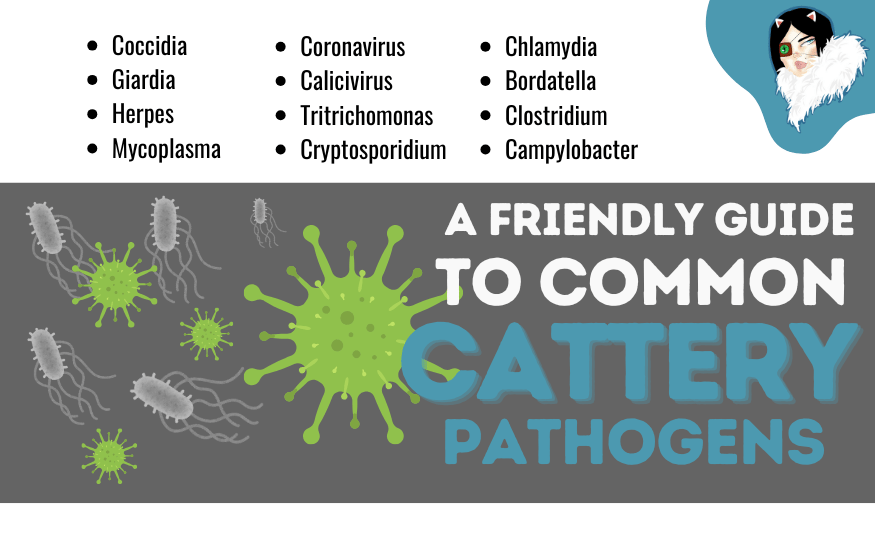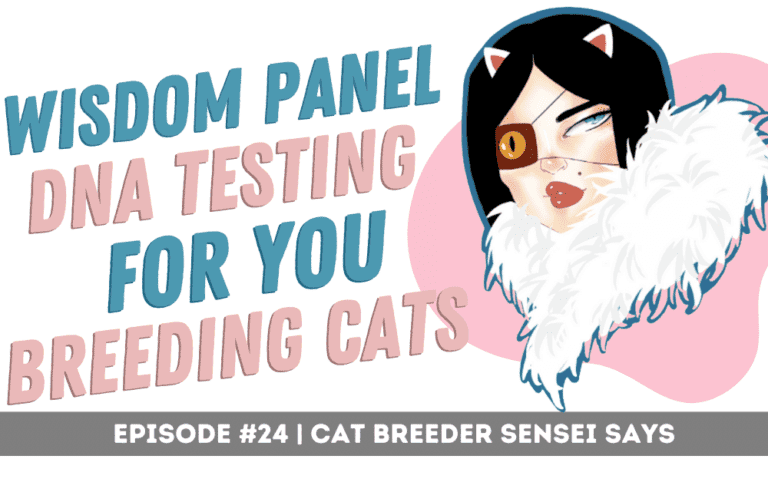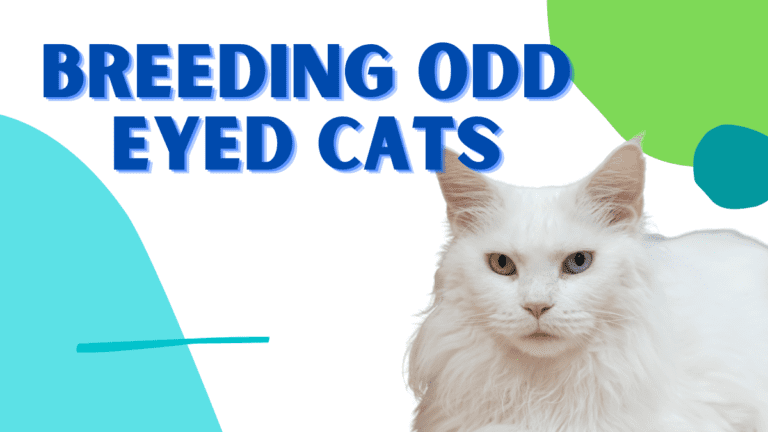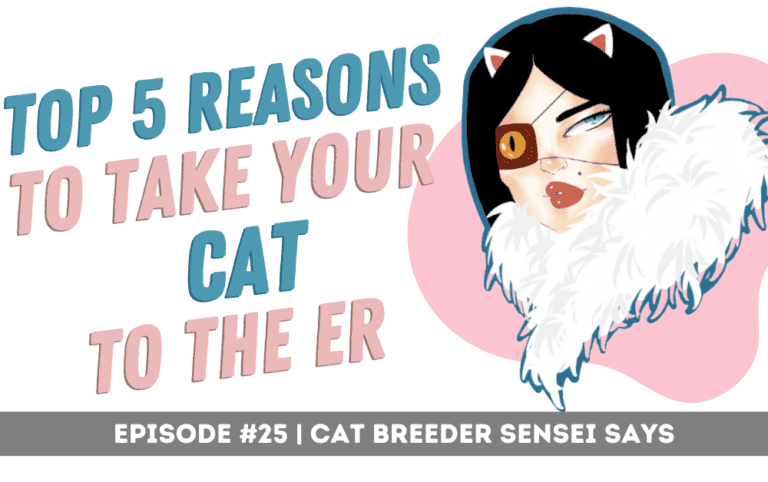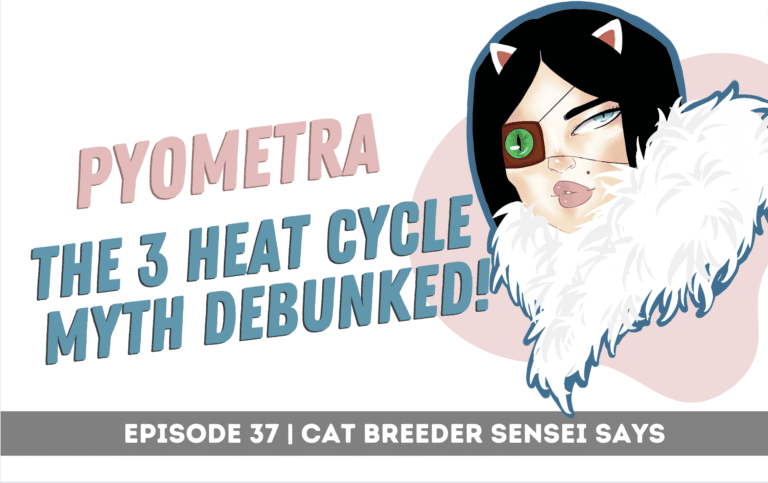A Friendly Guide to Common Cattery Pathogens
If you’ve ever heard scary stories about viruses and bacteria in catteries, don’t worry. This guide is like a big, warm hug to help you understand these germs without fear.
We’re going to talk about some common pathogens that you’ll find in catteries—mycoplasma, calicivirus, feline herpesvirus, and more! You’ll learn what they are, where they come from, their symptoms, how to identify and treat them, why quarantine matters, some stats, how they compare to human illnesses, when to consider retiring a cat, and how to keep kittens strong. By the end, you’ll feel confident and ready to keep your cattery thriving!
Catteries are like big cat families living close together, so germs can spread easily. But with the right knowledge, you can handle these germs calmly and keep your cats healthy. Think of this as your superhero guide to being a smart breeder.
Let’s review the most common pathogens that you will likely encounter at some point in your career as a Pedigree cat breeder.
DISCLOSURE: We’re not veterinarians, but Pedigree Cat Breeders sharing our knowledge. Please always consult with your vet before starting treatment. medicine, dosing, and duration can vary based on your cats’ condition.
Pathogen Treatment Summary Table
| Pathogen | Type | Treatment | Dose |
|---|---|---|---|
| Mycoplasma | Bacteria | Doxycycline | 10 mg/kg once daily or 5 mg/kg twice daily x 14 days |
| Chlamydia | Bacteria | Doxycycline | 10 mg/kg once daily or 5 mg/kg twice daily x 14 days |
| Calicivirus | Virus | Supportive Care | |
| Herpes | Virus | Supportive care + Famciclovir (Rx) | Famciclovir: 40–90 mg/kg every 8–12 hrs |
| Bordatella | Bacteria | Doxycycline | 10 mg/kg once daily or 5 mg/kg twice daily x 14 days |
| Coronavirus | Virus | Supportive Care or GS-441524 for FIP | For cats or Kittens with FIP, Contact FIP Warriors |
| Giardia | Protozoa | Fenbendazole or Metronidazole | Fenbendazole: 50 mg/kg once daily x 5 days Metronidazole: 25 mg/kg twice daily x 5–7 days |
| Clostridium | Bacteria | Metronidazole or Clavamox (Rx) | Metronidazole: 10–15 mg/kg twice daily Clavamox: 12.5 mg/kg twice daily x10 days |
| Coccidia | Protozoa | Toltrazuril or Sulfadimethoxine (Rx) | Toltrazuril: 15 mg/kg once daily x 3 days Sulfadimethoxine: 55 mg/kg first day, then 27.5 mg/kg daily |
| Tritrichomonas | Protozoa | Ronidazole | Ronidazole: 30 mg/kg once daily x 14 days |
| Cryptosporodium | Protozoa | Azythromycin | 110 mg/kg once daily x 14 days |
| Campylobacter | Bacteria | Erythromycin or Clindamycin | (10–15 mg/kg twice daily) x 14 days |
Notes for Breeders:
- Ronidazole is effective but monitor closely for neuro signs.
- Fenbendazole (Panacur) is widely used and safe for Giardia, with low resistance.
- Clostridium overgrowth is often secondary; address diet, stress, or recent antibiotic use.
- Cryptosporidium is highly resistant to most treatments—focus on hygiene and supportive care.
Respiratory Pathogens
Respiratory pathogens are one of the most common health concerns in catteries. These infectious agents—ranging from viruses like feline herpesvirus and calicivirus to bacteria like Bordetella and Mycoplasma—can spread rapidly through sneezing, grooming, and shared living spaces. Infections often present with sneezing, watery eyes, and nasal discharge, but in kittens or immunocompromised cats, symptoms can quickly escalate and become life-threatening.
This guide will help you recognize the signs early, implement strict quarantine protocols, and treat affected cats promptly to prevent widespread outbreaks.
With any pathogen, it’s super tricky to figure out which germ is causing the trouble just by looking at your cat. The only way to know for sure is with a PCR test, which is like a detective that finds the exact DNA of the virus or bacteria. Your vet can take a swab from your cat’s nose, eyes, or mouth and send it to a lab to get the real scoop. You can also do your own through Noble Maines Labs. They specialize in work with cat breeders.

Mycoplasma: The Sneaky Bacteria
Mycoplasma is a tiny bacterium that doesn’t have a cell wall, making it a bit sneaky. It loves to hang out in a cat’s eyes, nose, or lungs, causing mild to moderate trouble. Mycoplasma can be part of the normal flora but may cause disease under certain conditions. A PCR is required to detect mycoplasma. You can also see it under a microscope in eye scrapings.
Transmission occurs through direct contact with infected cats. When cats share food bowls, groom each other, or sneeze. It’s common in catteries or shelters where cats are close together.
Think of mycoplasma like a mild cold you get from a friend. It’s annoying but goes away with rest and maybe some medicine. No need to panic! About 3-20% of cats in catteries carry mycoplasma, especially in crowded places. It’s common but not a catastrophe!
You rarely need to retire a cat for mycoplasma. Once treated, most cats are fine. Only consider retirement if a cat keeps getting sick despite treatment and stresses the cattery.
Symptoms
- Runny eyes or nose (like a cat cold)
- Sneezing or coughing
- Red, sore eyes (conjunctivitis)
- Sometimes breathing trouble if it gets to the lungs
Treatment Plan
Doxycycline is a superhero that zaps the bacteria. Eye ointments like Terramycin or Neomycin can help sore eyes. Most cats feel better in a week or two.
Calicivirus: The Mouth and Nose Troublemaker
Feline calicivirus (FCV) is a virus that loves to cause sneezes and mouth sores. It’s super common in cats and spreads easily. Vets diagnose FCV by looking at symptoms like mouth ulcers and doing a PCR test on swabs from the mouth or eyes. It’s often confused with herpesvirus, so testing is key. It is known for its ability to mutate, leading to varying strains.
FCV spreads through saliva, eye or nose discharge, or even sneezes that travel through the air. It’s a big deal in catteries because it can live on surfaces like bowls or bedding. FCV is like a bad flu in a human with a sore throat. It makes you feel icky, but with rest and soup, you’re back to normal soon.
Up to 40% of cats in catteries might have FCV, and 10% in private homes. It’s super common, but most cats recover fully. Kittens get hit harder because their bodies are still learning to fight germs. Feed them high-quality kitten food, keep their home calm, and vaccinate them starting at 6 weeks to help protect them. You can use the FVRC vaccines from Revival.
This virus may damage the mucous membranes, allowing bacteria like Pasteurella, Streptococcus, Staphylococcus) to cause infections.
Only retire a cat if they carry a severe strain (like VS-FCV) that keeps causing outbreaks, or if they’re always sick and spreading it.
Symptoms
- Sneezing and runny nose
- Ulcers on the tongue or mouth
- Watery eyes
- Sometimes limping (called “limping syndrome”)
- Rarely, a severe form causes fever and swelling
Treatment Plan
There’s no magic pill for viruses, but you can help your cat feel better with the following supportive care:
- Pain relief for mouth sores
- Antibiotics for secondary infections
- Keeping them hydrated (like giving them yummy wet food)
- A humidifier or steamy bathroom to ease breathing Most cats recover in 7-10 days, though some carry the virus longer.
- Clavamox to prevent Secondary Infection
Put sick cats in their own space with separate bowls and litter boxes. FCV can spread like glitter—fast and everywhere! Clean surfaces with bleach to kill the virus.
Herpesvirus: The Lifelong Sneaky Guest
Feline herpesvirus (FHV-1), or feline viral rhinotracheitis, is a virus that causes eye and nose problems. Once a cat gets it, it stays in their body forever. Vets suspect FHV-1 from symptoms and confirm with a PCR test on eye or nose swabs. It’s the top cause of cat conjunctivitis.
Up to 97% of cats have been exposed to FHV-1, and 80% carry it for life. About 45% shed it when stressed. It’s everywhere, but manageable!
It spreads through direct contact, like nose-to-nose snuggles or shared litter boxes. Stress can wake it up in carriers, causing flare-ups. FHV-1 is like a cold sore in humans. It pops up when you’re stressed, but you can live with it just fine.
Keep sick cats separate to stop the virus from spreading through sneezes or shared items. Disinfect with bleach, as FHV-1 dies quickly outside the cat. Kittens are super vulnerable, and FHV-1 can be serious for them. Vaccines at 6-8 weeks, a cozy environment, and good nutrition help their tiny immune systems fight back.
This virus may damage the mucous membranes, allowing bacteria like Pasteurella, Streptococcus, Staphylococcus) to cause infections.
Retire a cat only if they have severe, frequent flare-ups that harm their quality of life or spread to others despite care. This is rare.
Symptoms
- Sneezing and stuffy nose
- Goopy or red eyes (conjunctivitis)
- Eye ulcers (painful!)
- Fever and tiredness
- Loss of appetite
Treatment Plan
Support your cat with:
- Eye drops for sore eyes
- Antibiotics for bacterial infections
- Antiviral medicine (famciclovir) to reduce the duration
- Lysine supplements to slow the virus
- Fluids and yummy food to keep them strong Most cats recover in 10-14 days, but stress can cause flare-ups later.
- Clavamox to prevent secondary infections
Chlamydia: The Eye Infection Culprit
Chlamydia felis is a bacterium that loves to cause eye infections in cats. It’s not the same as human chlamydia, so don’t worry! Vets use PCR tests on eye swabs to find chlamydia DNA. They might also see it in eye scrapings under a microscope.
It spreads through eye discharge when cats are close, like in catteries. It needs direct contact to hop from cat to cat. Separate sick cats to stop the spread through eye goop. Clean their bedding and bowls, and wash your hands after touching them.
About 15-20% of cats with respiratory signs in catteries have chlamydia, but only 3% of healthy cats carry it. It’s common but treatable. Chlamydia is like pink eye in kids. It’s irritating but clears up with medicine and good hygiene. Kittens get chlamydia more often because their eyes are sensitive.
Retirement is almost never needed. Once treated, cats usually recover fully and don’t spread it.
Symptoms
- Watery eyes that turn yellow or goopy
- Red, puffy eyes
- Sneezing (but not always)
- Mild fever
Treatment Plan
Antibiotics like doxycycline or eye ointments (Neomycin) zap chlamydia. Most cats are better in a couple of weeks with proper care. Focus on boosting kittens’ immune system with proper nutrition, vaccines, and a clean environment.
Bordetella: The Kennel Cough Cousin
Bordetella bronchiseptica is a bacteria that causes respiratory issues, similar to kennel cough in dogs. It’s less common in cats but can pop up in catteries. Vets culture the bacteria from nose or throat swabs or use PCR tests. Symptoms alone aren’t enough, as they mimic other germs.
It spreads through the air with sneezes, coughs, or contact with infected dogs or cats. Crowded places like catteries increase the risk. Disinfect surfaces and keep the cattery airy to reduce spread. It’s like a cough you get from a crowded bus. Rest and medicine fix it, and it’s not a big deal.
Retirement is almost never needed. Treated cats recover and don’t usually carry it long-term.
Symptoms
- Coughing or sneezing
- Runny nose or eyes
- Fever
- In rare cases, breathing trouble in kittens
Treatment Plan
Antibiotics like doxycycline work well. Supportive care, like fluids and rest, helps cats recover in 1-2 weeks.
Fecal Pathogens
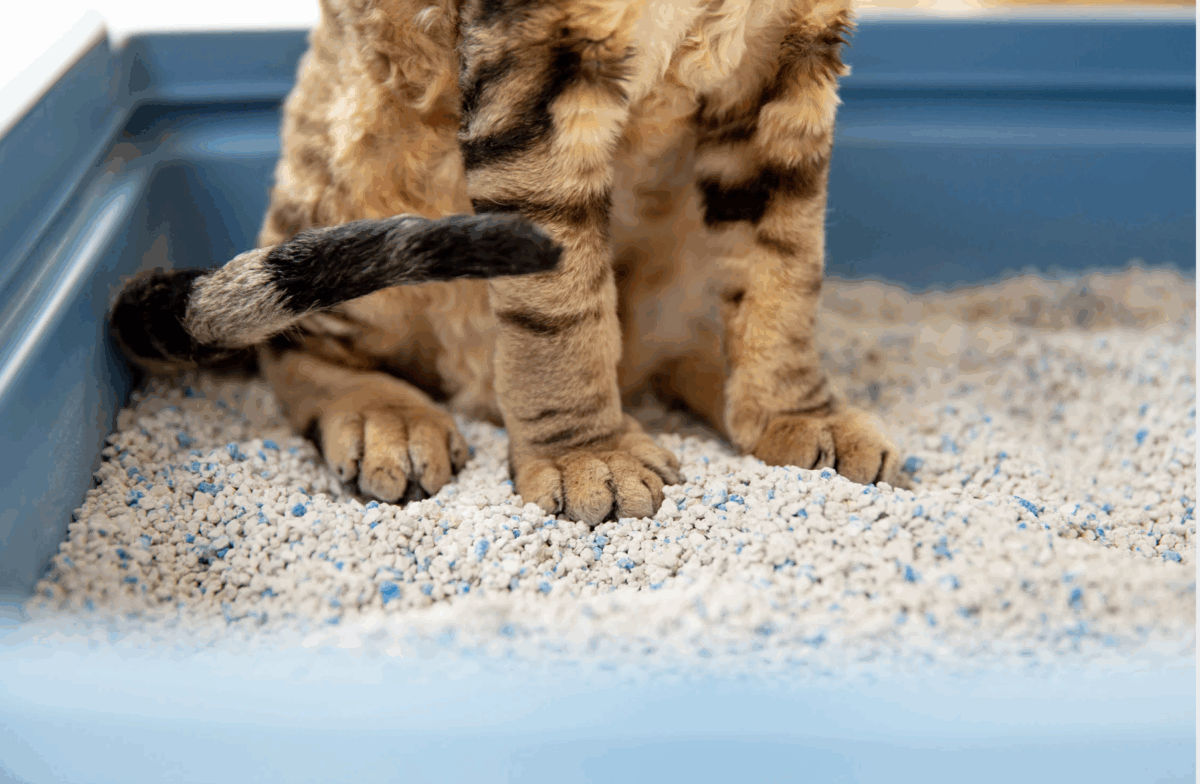
Fecal pathogens are another major health challenge in catteries, especially where kittens are involved. Parasites like Giardia, Coccidia, and Tritrichomonas, along with bacteria such as Clostridium, can silently sweep through a cattery and cause persistent, messy, and sometimes severe diarrhea.
These organisms are often spread through contaminated litter boxes, shared grooming habits, or simple contact with infected surfaces. Because some cats can be asymptomatic carriers, it’s easy for these pathogens to go unnoticed until multiple cats show signs of illness. Early detection, strict hygiene practices, and targeted treatments are critical for keeping the cattery environment clean, the cats healthy, and your breeding program running smoothly.
Giardia
Giardia is a protozoan parasite that colonizes the small intestine. Cats become infected by ingesting cysts from contaminated water, food, or through direct contact with infected feces. Catteries are particularly susceptible to rapid spread. 10–45% of cats in catteries or multi-cat environments test positive for Giardia duodenalis. 30–40% of cattery kittens carry Giardia—many of them without symptoms.
In kittens under 6 months, the rate can be even higher, especially in dense or less strictly sanitized environments.
- Giardia spreads through cysts in feces, which can survive for weeks in moist environments.
- Communal litter boxes, grooming, and contaminated surfaces make it nearly impossible to eliminate without rigorous hygiene and quarantine protocols.
- Asymptomatic carriers shed the parasite, making detection and control even more difficult.
So in short: it’s extremely common, especially in kitten rooms, new litters, and high-density setups. Routine fecal screening, especially in young cats, is essential.
Symptoms
- Chronic, foul-smelling diarrhea that may be greasy and float.
- Weight loss and lethargy.
- Occasional vomiting.
Treatment Plan
Common treatments include metronidazole or fenbendazole. Environmental decontamination is crucial, as cysts can survive for extended periods. Regular cleaning and disinfection of litter boxes and living areas are recommended.
Coccidia
Cystoisospora felis and Cystoisospora rivolta are coccidian parasites affecting cats, especially kittens. Infection occurs through ingestion of sporulated oocysts from contaminated environments. 5–25% of cats in catteries, shelters, or breeding facilities may test positive for Coccidia, especially in environments with young kittens.
In kittens under 12 weeks, prevalence can spike to 30% or more, especially when hygiene and litter box cleaning aren’t tightly managed. Stress, weaning, and rehoming can trigger outbreaks in kittens already exposed but not yet symptomatic.
Adult cats often act as asymptomatic carriers, shedding low levels into the environment and infecting susceptible kittens. Coccidia oocysts are shed in feces and become infectious after 1–2 days.
Clinical Signs
- Watery or bloody diarrhea.
- Vomiting and abdominal discomfort.
- Dehydration and weight loss in severe cases.
Treatment
Treatment typically involves sulfonamide antibiotics, toltrazuril or ponazuril. They’re highly resistant to standard disinfectants and can survive in the environment for long periods. Maintaining cleanliness in the cattery and regular fecal examinations can help prevent outbreaks.
Clostridium perfringens
Clostridium perfringens is a bacterium found in the environment and the intestines of animals. Clostridium is a normal gut bacterium, but it becomes pathogenic when it overgrows or produces excessive toxins. Up to 80% of healthy adult cats may carry Clostridium perfringens in their intestines without showing symptoms.
Outbreaks of diarrhea due to Clostridium tend to occur when there’s a diet change, Stress (from moving, new introductions, or weaning), Antibiotic use, and Co-infections with other pathogens like Giardia or Coccidia
Clinical Signs
- Acute or chronic diarrhea, sometimes with mucus or blood.
- Abdominal pain and bloating.
- Lethargy and decreased appetite.
Treatment
Antibiotics like amoxicillin or metronidazole are commonly used. Probiotics and dietary management can aid recovery.Ensuring consistent feeding routines and minimizing stress can help prevent occurrences.
Tritrichomonas
Tritrichomonas blagburni is a protozoan parasite affecting the large intestine of cats. Transmission occurs through direct contact with infected feces, often via shared litter boxes or grooming. It’s prevalent in young cats and densely populated catteries.
Studies suggest 14–30% of purebred cats in catteries may test positive for tritrichomonas. In high-density catteries or show circuits, that rate can climb even higher. It’s more common in:
- Catteries with shared litter boxes and no quarantine for newcomers
- Young cats (especially under 1 year)
- Purebred cats, especially Abyssinians, Bengals, and Siamese
Tritrichomonas is highly contagious, but unlike Giardia, it doesn’t form a cyst stage—so it requires direct, fresh fecal-oral contact to spread (like through grooming or shared boxes). Cats can shed it for months to years, even if symptoms improve. Standard fecal float tests often miss it—you need a PCR test to diagnose accurately.
Clinical Signs
- Chronic, foul-smelling, cow-patty diarrhea
- Often contains mucus or blood
- Straining to defecate, sometimes mistaken for constipation
- Inflamed and painful anus.
Treatment
Ronidazole is the treatment of choice, though it’s not approved for feline use in all countries and should be administered under veterinary supervision. In some cases, symptoms may resolve over time without treatment, but cats can remain carriers.
Campylobacter
Campylobacter is a zoonic bacteria that can be transmitted to humans, especially children and immunocompromised adults. It’s often subclinical, especially in adults. Found in as many as 30–45% of kittens, even those without symptoms. Can be acquired from undercooked meat or raw feeding.
Diagnosis can be tricky without a PCR panel, and treatment isn’t always required unless the symptoms are severe. In those cases, antibiotics like erythromycin may be prescribed. Because it often appears alongside other pathogens like Giardia or Clostridium, Campylobacter deserves a spot on every breeder’s radar when dealing with persistent or unexplained diarrhea.
Symptoms (Mostly in Kittens)
- Watery or Bloody Diarrhea (Sometimes Explosive)
- Very Foul Odor
- Mucus in Stool
- Feverl, Vomiting and abdominal Pain (lEss Common)
- May be Intermittent or Chronic
Treatment Plan
Mild cases often resolve without antibiotics. Persistent or severe cases can be treated with Erythromycin or Clindamycin. (Sensitivity test should be performed prior to administering antibiotics)
Feline Coronavirus: The Tricky One
Feline coronavirus (FCoV) is a virus that usually causes mild tummy troubles but can sometimes turn into a serious disease called feline infectious peritonitis (FIP). Vets test poop or blood for FCoV with PCR or antibody tests. FIP is harder to diagnose and may need fluid samples or biopsies.
It spreads through poop, especially in shared litter boxes. It’s super common in multi-cat homes like catteries. Separate cats with diarrhea to stop FCoV spread. Clean litter boxes daily with disinfectant to keep the virus in check. FCoV is like a stomach bug—most people get over it, but rarely it causes worse problems. FIP is like a rare complication from that bug.
20-60% of cats in catteries have FCoV, and up to 90% in crowded places. Only 5-14% develop FIP, so it’s rare. Kittens are at higher risk for FIP if their immune systems are weak.
Retire a cat only if they develop FIP, as it’s often fatal and stressful. Some breeders choose to retire an adult if it produces kittens that get FIP. Cats with mild FCoV can stay if managed well.
Symptoms
- Mild diarrhea or no symptoms
- If it turns into FIP (rare), you might see:
- Swollen belly (wet FIP)
- Weight loss or fever (dry FIP)
- Tiredness
Treatment Plan
- For mild FCoV, supportive care like good food and hydration helps.
- FIP is tougher, but new antiviral drugs (like GS-441524) show promise.
Quarantining Symptomatic Cats: Why It’s a Non-Negotiable in Catteries
When a cat starts showing symptoms of illness—especially respiratory signs or diarrhea—it’s critical to quarantine them immediately. In a cattery setting, pathogens can spread like wildfire through shared litter boxes, food dishes, bedding, and even through the air. Quarantine isn’t just a best practice—it’s your first line of defense against an outbreak.
Implementing quarantine protocols is also vital when introducing new cats to a cattery. Isolation prevents the spread of infectious agents to healthy cats. A minimum quarantine period of 14 days is recommended, during which the cat should undergo thorough veterinary evaluation, including fecal testing and treatment.
Why We Quarantine:
- Prevent transmission to healthy cats, especially kittens or pregnant queens
- Observe symptoms more clearly without cross-contamination
- Protect your entire cattery from a potential outbreak
- Monitor treatment response without outside variables
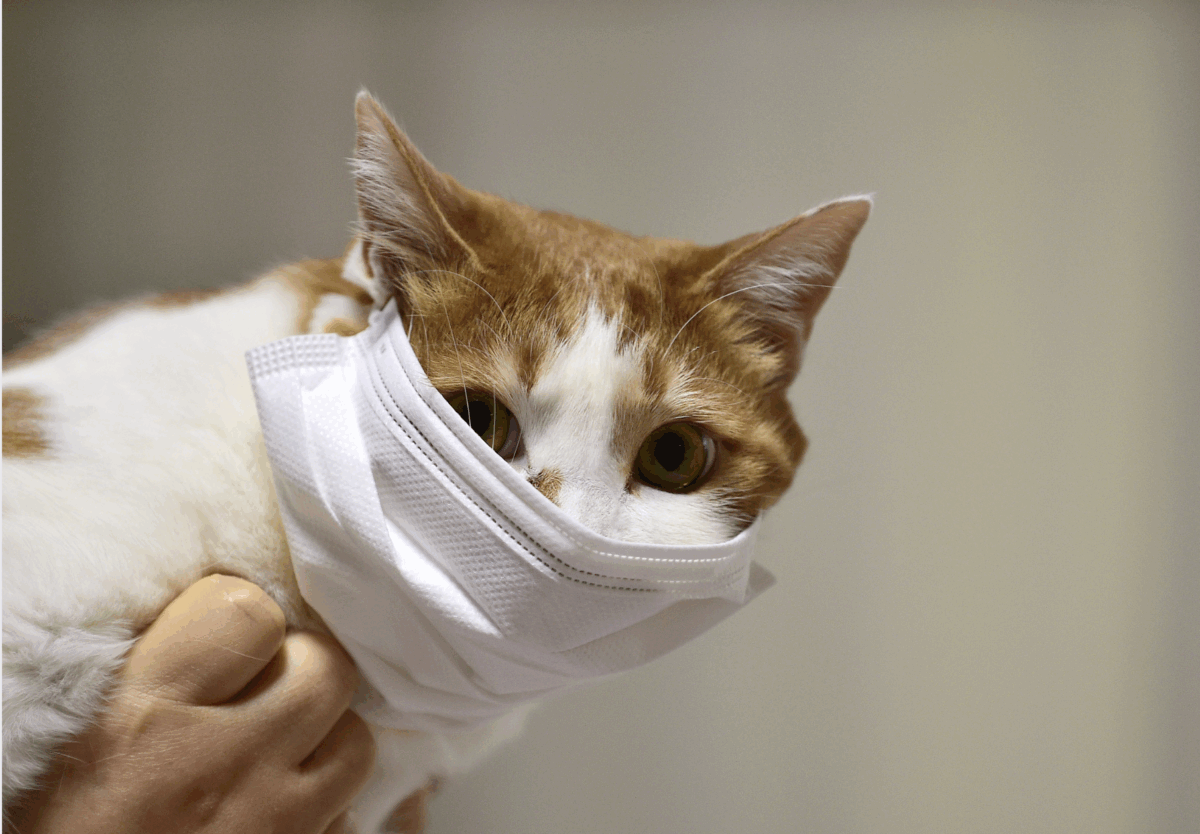
How to Properly Quarantine a Cat
Quarantining a cat isn’t just about isolating them in another room—it’s about creating a controlled, sanitary environment where the cat can heal without putting the rest of your cattery at risk. Whether you’re dealing with diarrhea, sneezing, or something more serious, proper quarantine protocols can be the difference between a minor setback and a full-blown outbreak.
The ideal quarantine setup is a completely separate room—not just a corner of an open space. This area should have solid walls, its own door, and no shared air circulation, if possible. The quarantined cat needs its own litter box, food and water dishes, bedding, and toys. Nothing in that room should be used for any other cat, period.
Here are a few key setup tips:
- Choose a room that’s easy to disinfect—avoid carpeted areas if possible.
- Use plastic or stainless steel bowls and litter pans (easier to sanitize).
- Keep the environment calm and low-stress, with minimal foot traffic or other animals nearby.
When you care for your cats each day, always start with your healthy cats first and the quarantined cat last. This reduces the risk of carrying pathogens back into the main cattery. You should also change clothes, or at the very least wear a dedicated robe or apron while handling the quarantined cat. Wash your hands after every interaction—or better yet, use gloves and hand sanitizer for extra precaution.
Disinfection is just as important as isolation. Clean surfaces, bowls, and litter boxes daily with appropriate disinfectants based on the suspected or confirmed pathogen. For example, Giardia cysts need bleach (1:32 dilution), while Calicivirus requires a hydrogen peroxide-based cleaner. Don’t assume your all-purpose spray will cut it—many pathogens are incredibly resistant to basic cleaning products.
Finally, observe and document everything. Keep a small notebook or chart in the quarantine room to track symptoms, medications, stool consistency, appetite, and behavior. This helps you and your vet monitor progress, and it can be useful in identifying patterns across litters or bloodlines.
Quarantine isn’t convenient, but it’s an essential part of running a responsible, ethical cattery. It protects your kittens, your breeding lines, your reputation—and most importantly, the cats themselves.
Boosting Kitten Immune Systems
Kittens are born with immature immune systems and rely heavily on passive immunity acquired through colostrum—the antibody-rich first milk produced by the queen. This passive immunity provides critical protection during the first few weeks of life. However, maternal antibodies can interfere with the effectiveness of vaccinations, making the timing of immunizations crucial.
By implementing this protocol, you can proactively support the development of strong immune systems in your kittens, reducing the risk of disease, pathogens and promoting overall health and vitality in your cattery.
Colostrum & Early Nutrition
- Immediate Nursing: Ensure kittens nurse within the first 16–24 hours to absorb colostrum effectively.
- Supplementation: For orphaned or rejected kittens, administer 3–5 ml of serum from a healthy, vaccinated adult cat subcutaneously or intraperitoneally to provide passive immunity
Hygiene & Stress Reduction
- Clean Environment: Maintain a warm, dry, and clean nesting area to minimize pathogen exposure.
- Minimize Stress: Limit handling to essential care to reduce stress-induced immunosuppression.
Core Vaccines: FVRCP (Feline Viral Rhinotracheitis, Calicivirus, Panleukopenia)
- Initiation: Begin vaccinations at 6–8 weeks of age.
- Booster Schedule: Administer boosters every 3–4 weeks until the kitten is at least 16–20 weeks old.
Optional Early Intranasal Vaccines
- Intranasal FHV-1/FCV: Can be administered as early as 4 weeks of age, particularly in high-risk environments.
Nutrition & Supplementation
Diet
- High-Quality Food: Provide a balanced, high-protein diet appropriate for kittens to support immune development.
Supplements
- Probiotics: Introduce kitten-safe probiotics to promote gut health.
- Omega-3 Fatty Acids: Consider supplements to support overall immune function
Stress Management & Environmental Enrichment
- Routine: Establish consistent feeding and care schedules.
- Socialization: Gradually introduce kittens to gentle handling and play to build confidence and reduce stress.
- Cleanliness: Regularly clean and disinfect living areas to reduce pathogen load.
Sanitation & Biosecurity
- Hand Hygiene: Wash hands thoroughly before and after handling kittens.
- Footwear: Use dedicated footwear or shoe covers in kitten areas.
- Quarantine: Isolate new or sick animals to prevent disease spread.
Should You Retire Your Breeding Cat Because of a Pathogen?
When it comes to breeding cats that have been exposed to or diagnosed with fecal or respiratory pathogens, it’s important to approach each case with perspective rather than panic. The presence of a pathogen—like Giardia, Clostridium, Herpesvirus, or even Tritrichomonas—is not an automatic reason to retire an otherwise healthy, valuable breeding cat. Many of these organisms are widespread in multi-cat environments, and it’s not uncommon for a cat to be an intermittent shedder without ever displaying clinical illness.
In most cases, these infections can be managed successfully with treatment, quarantine, and strong hygiene protocols. A cat that recovers well, tests clean (or low shedding), and maintains good condition, temperament, and reproductive health can still contribute meaningfully to a breeding program. The decision to retire should never be based solely on a positive test—it should consider the full context: Is the infection chronic and unresponsive to treatment? Is the cat repeatedly symptomatic? Are other cats in the cattery at risk despite preventive measures?
Retirement may become necessary if the cat has:
- Recurrent, unmanageable symptoms (e.g., constant diarrhea or sneezing despite treatment)
- Becomes a chronic source of transmission even after multiple quarantine periods
- Fails to thrive reproductively or care for kittens appropriately due to illness
But these are the exception, not the rule. In most situations, a cat that has dealt with a pathogen but bounced back—especially with responsible management—shouldn’t be discarded from your program. Instead, focus on supporting the immune system, minimizing stress, and maintaining high sanitation standards.
Ultimately, the decision to retire a cat should be based on its long-term health, temperament, and contribution to your breeding goals—not fear of a common pathogen.
Final Thoughts: You’ve Got This
Dealing with pathogens—whether it’s Giardia, Herpesvirus, Tritrichomonas, or anything in between—can feel overwhelming at first. But here’s the truth: every cattery will face health challenges at some point. What sets a great breeder apart isn’t having a sterile, problem-free environment—it’s having the knowledge, tools, and confidence to respond calmly and effectively when issues arise.
Most of the pathogens we’ve covered are common, manageable, and treatable, especially when caught early and handled with quarantine, targeted treatment, and a little extra TLC. A positive diagnosis doesn’t mean failure, and it certainly doesn’t mean you have to retire a healthy, valuable cat. With proactive care and smart protocols in place, your cats can thrive—even after a bump in the road.
So breathe. Stay consistent. And remember: you’re not alone—every breeder who’s ever raised a litter has been right where you are now. You’ve got the knowledge, you’ve got the resources, and your cattery is stronger for it.

Get the Training and Support That You Need
When you become a member today, you’ll have instant access to a personal mentor who will be there for you and give you the answers you need.
Not only this, you’ll also get access to:
- Step-by-Step Training Courses about Breeding Cats
- Full Blueprints for Marketing Your Cattery and running your business professionally
- Unlock TikTok For Your Cattery with the course on Viral Video Creation
- Digital Resources and Tools
- Invite Only to our Discord
- Exclusive Deals on SpaySecure and Sensei Store
- Monthly “Members Only” Training Calls

